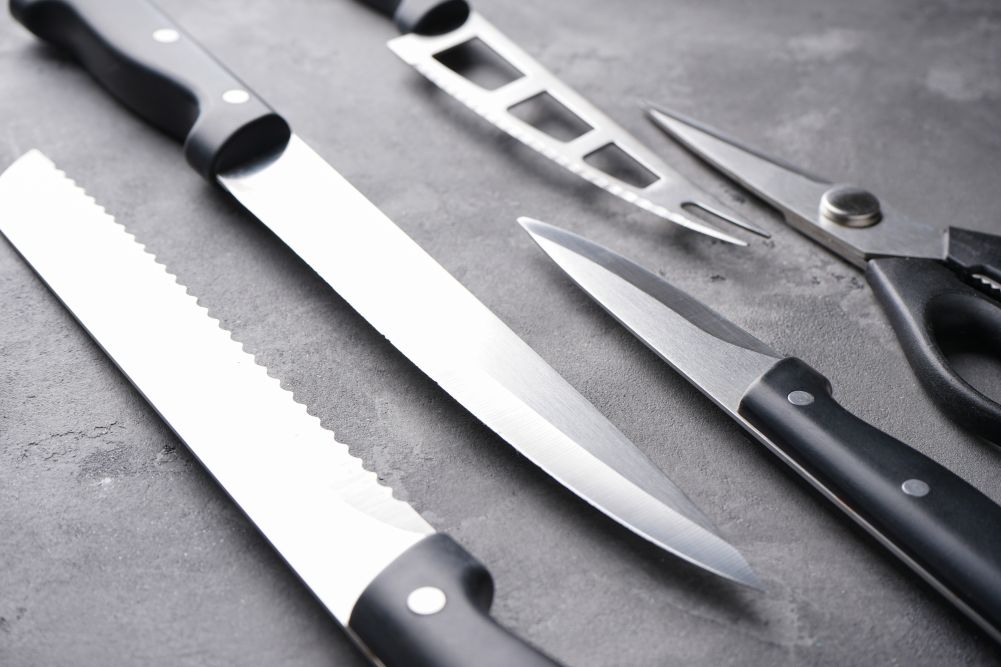One of the key safety features for most utility knives on the market is the ability to retract the blade into the handle casing when it is not in use. When retracted, the blade is essentially tucked away where it can be easily carried or stored without the sharp parts of the knife blade accessible to cut anyone or anything.
There used to be a time when blades could only be exposed manually and required that the slide or button on the utility knife be pressed or moved in order to put the blade in a closed or retracted position.
More recently, though, two additional retraction options have been developed, which help to automate this process and attempt to create a safer utility knife. These are auto-retracting and self-retracting utility knives.

Table of Contents
Auto-Retracting Utility Knives
Utility knives with auto-retracting mechanisms have a spring-loaded blade that requires the user to engage and hold a button or slide it in order for the blade to remain exposed.
Once the user lets go of the blade button, the blade will retract into the handle automatically. This means that any auto-retracting utility knife that is not actively being held will be in a retracted blade position.
The goal behind this safety feature was to eliminate accidents from utility knives that were dropped, set down, or stored without the blade retracted.
Self-Retracting Utility Knives
The self-retracting option takes the innovation of the auto-retracting blade idea, then goes one step further.
In addition to the user having to hold a button or slide for the blade to remain exposed, self-retracting utility knives also require there to be pressure on the cutting surface.
If the person who is holding the blade lets go of the mechanism or if the blade is no longer in contact with a cutting surface, the blade retracts into the handle.
This helps to further reduce the number of lacerations, particularly those that result from a blade slipping during the cutting process.
Which is Safer?
In terms of safety, self-retracting utility knives are the better choice. First and foremost, these utility knives protect the user in a much wider range of circumstances and scenarios than their auto-retracting counterparts.
Secondly, the dual design of the retraction mechanism makes it much harder, if not impossible, to bypass the safety feature.
If a person chose to tightly wrap tape to hold the button or slide mechanism down on an auto-retracting utility knife, the result would be a complete loss of the retraction function.
However, with the self-retracting option, this manipulation would not work because there are two requirements for the blade to remain exposed.
Which is Better?
Deciding between a self-retracting utility knife and one that is auto-retracting largely depends on what you will be using it for.
While the self-retracting knife is probably a safer choice, it may not be the best choice in every application.
If the material that you are cutting is not fairly even and smooth, the pressure applied to the blade of the knife may not be either, triggering the retraction mechanism unnecessarily. This could become quite a nuisance and create more frustration and work for the user overall. In this scenario, an auto-retracting blade may be a better choice.
What about Price?
While the overall price points of utility knives can vary greatly from brand to brand, self-retracting options really are not much more expensive than auto-retracting options.
Additionally, self-retracting and auto-retracting utility knives can be the same price as a manual utility knife, even if it’s from the same brand.
In many cases, most of the utility knife materials will be relatively the same across all styles, yielding a similar cost. Things like the brand name will often be the bigger price determinate.
Tips for Buying a Utility Knife
When choosing a brand, look for one that has a reputation for using quality materials. If possible, select a style with a ceramic blade instead of a metal one, since they usually last longer and are completely rust-free.
Zirconium oxide (a type of ceramic blade) also has the added bonus of being non-sparking, non-magnetic, and non-conductive, which may make a huge safety difference in some work environments.
When it comes to handles, it is important to purchase one that is tough and durable, but still feels comfortable in your hand and is easy to hold and grip. If you are left-handed, be sure that the slide or button mechanism is suited for ambidextrous use.
Final Word
Innovations in utility knives, such as the auto-retracting and the self-retracting functions, really do create a safer utility knife. When combined with common sense knife handling practices, both are helping to keep workplaces and users protected.